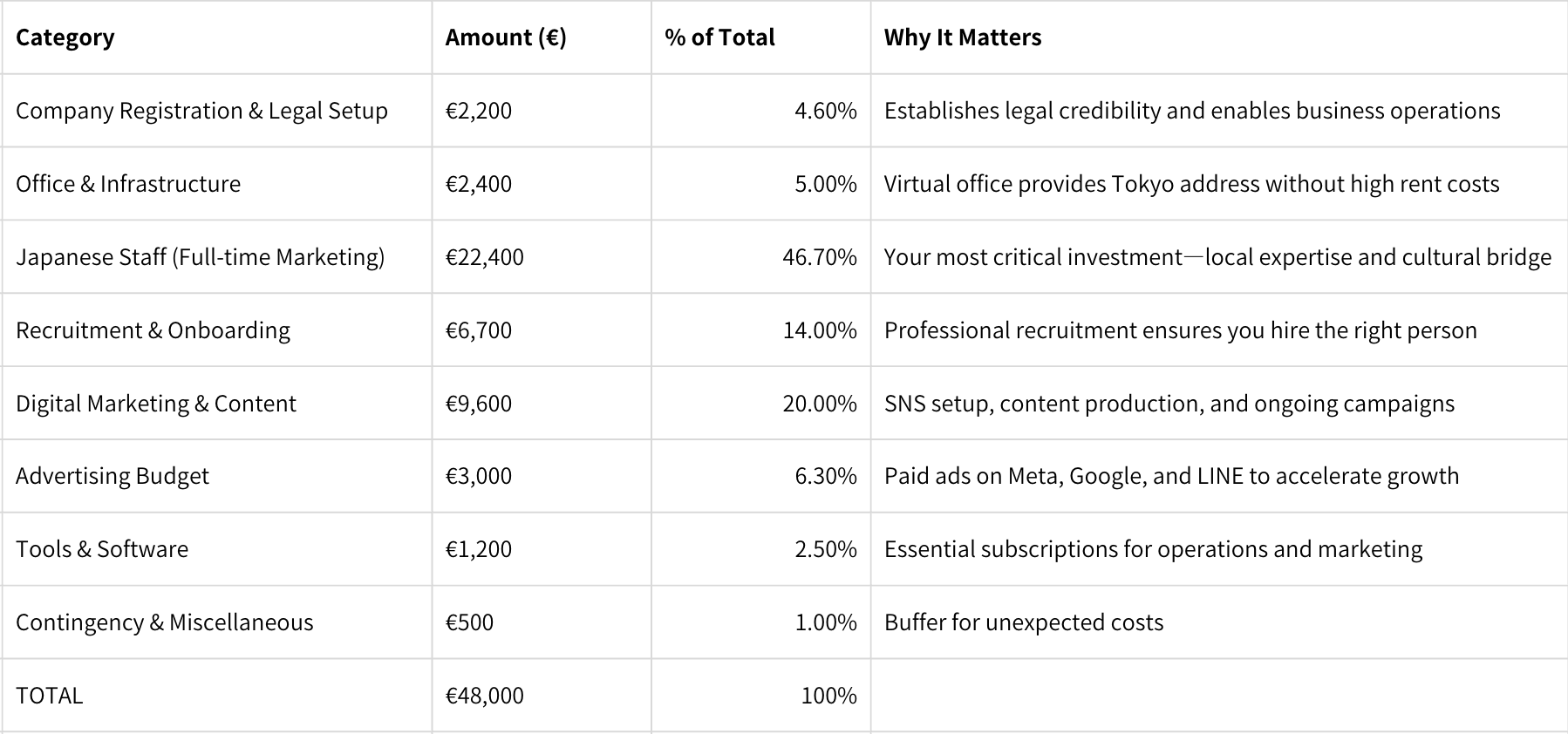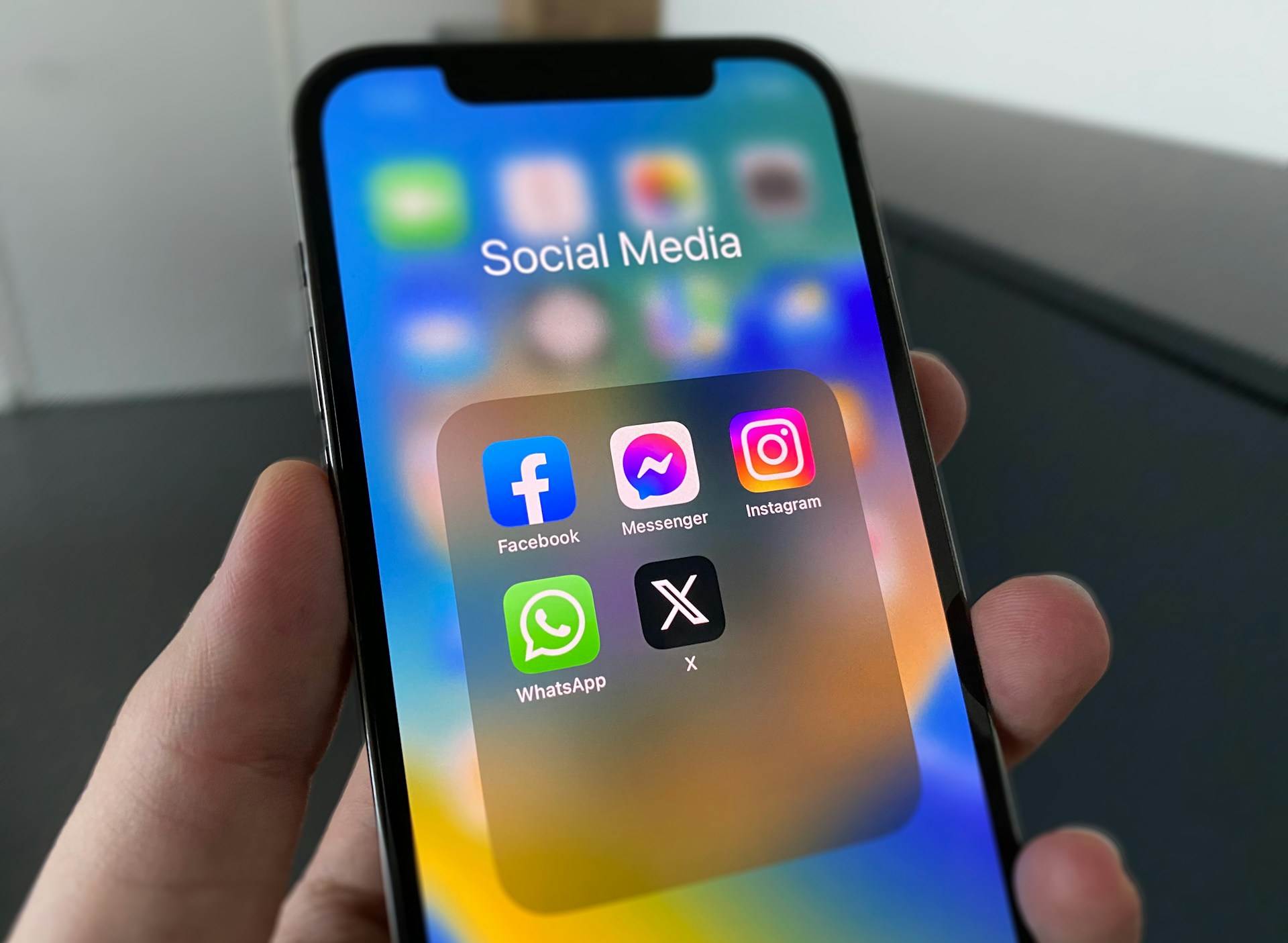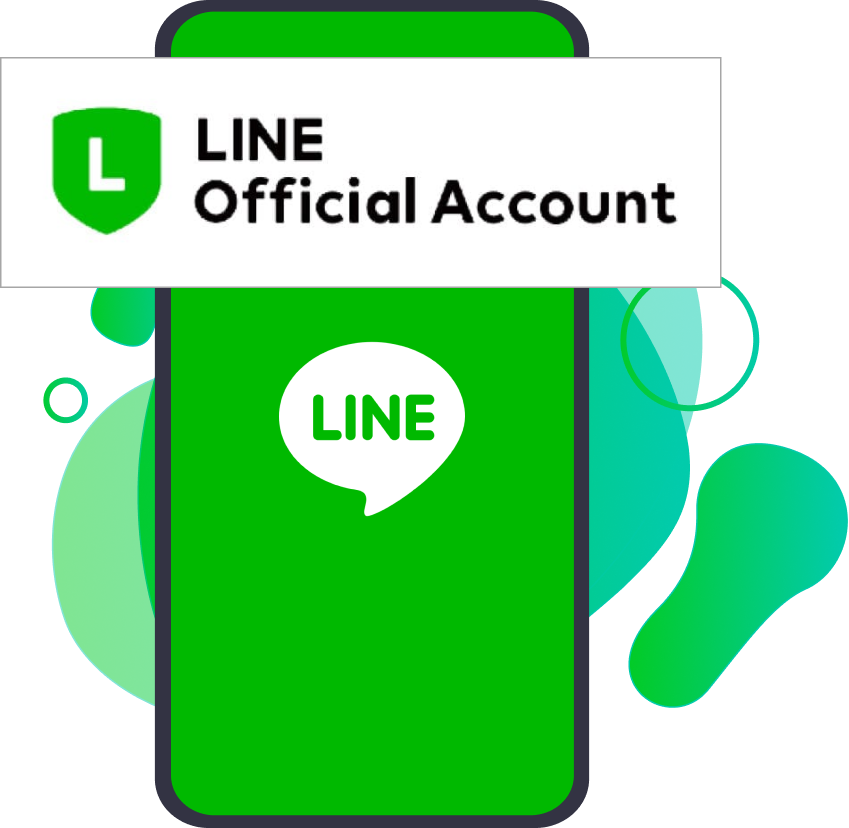
Why Now Is the Best Time for European SMEs to Enter Japan

While most consultants say you need $100,000 to enter the Japanese market, we're about to show you how European SMEs can do it with €48,000—and why November 2025 is the perfect timing.
Here's what's happening in Japan right now:

The Nikkei 225 surpassed 50,000 in November 2025, marking an all-time high and signaling sustained economic confidence. Japan's stock market isn't just recovering—it's thriving, driven by corporate reforms, increased foreign investment, and strong corporate earnings.
The yen has weakened significantly against the euro.
At an exchange rate of €1 = ¥179 (November 2025), European companies now enjoy approximately 30% more purchasing power compared to 2021 levels. Your marketing budget stretches further. Your operational costs are lower. Your competitive advantage is real.
Japan's economy remains the world's third-largest, with a GDP of $4.4 trillion. This isn't an emerging market gamble—it's a stable, affluent market of 125 million consumers with high purchasing power and strong brand loyalty.
Post-COVID digital acceleration has lowered the barrier to entry.
Japanese consumers who once preferred in-person transactions now embrace e-commerce, digital payments, and online services. Remote work has normalized virtual business relationships.
You no longer need a prestigious Tokyo office address to be taken seriously—you need a strong digital presence and cultural competence.
This article provides exactly what other "market entry guides" don't:
transparent, line-by-line costs for your first year in Japan.
No vague ranges. No hidden assumptions.
Just the real numbers a European SME needs to budget for a successful Year 1.
I'm writing this as a Japanese market entry specialist who has helped European brands navigate this exact process. The numbers you're about to see are based on real costs, real vendors, and real market conditions as of November 2025.
What this article covers:
- Complete first-year budget breakdown (€48,000)
- Month-by-month timeline and priorities
- What to spend on, what to skip
- How to maximize every euro in the Japanese market
What this article does NOT cover:
- Heavy manufacturing or physical product import (requires regulatory compliance budget)
- Pharmaceutical or food & beverage market entry (requires specialized licensing costs)
- Hiring 10+ employees from Day 1 (this is a lean, digital-first approach)
If you're a B2B SaaS company, D2C e-commerce brand, consulting firm, or service-based business looking to enter Japan with a realistic budget and digital-first strategy, this breakdown is for you.
Let's get into the numbers.
The Reality Check: What Other "Experts" Won't Tell You

Before we dive into the actual budget, let's address what you've probably already read elsewhere.
JML Group claims you need "at least $100,000 annually" to enter the Japanese market. Their analysis focuses heavily on regulatory compliance, food safety certifications, and pharmaceutical approvals—costs that are real but irrelevant for most digital-first SMEs.
JETRO (Japan External Trade Organization) estimates $120,000-$130,000 for establishing a subsidiary company. However, their model assumes you're setting up a permanent office in central Tokyo, hiring multiple full-time staff from Day 1, and paying substantial recruitment agency fees. For most European SMEs testing the Japanese market, this is overkill.
Here's what none of them tell you:
Most European SMEs entering Japan in 2025 don't need six-figure budgets.
What you need is a smart, phased approach that prioritizes digital marketing, local expertise, and cultural adaptation over expensive office leases and premature hiring.
The €48,000 budget we're about to break down is based on:
- Establishing a legitimate Japanese legal entity (Kabushiki Kaisha)
- Hiring one full-time Japanese marketing professional
- Building a strong digital presence (website, SNS, content)
- Running targeted digital advertising campaigns
- Maintaining flexibility with virtual office solutions
This is a realistic, achievable budget for European SMEs who want to enter Japan properly—not on the cheap, but not wastefully either.
Total Year 1 Budget:
€48,000 Breakdown

Here's how €48,000 breaks down across your first year in Japan:

The €48,000 budget is strategically allocated to ensure a successful market entry for European SMEs in Japan. It focuses on establishing a legal entity, hiring a local marketing expert, and building a robust digital presence. This approach prioritizes essential investments over unnecessary expenses, providing a clear path to market penetration.
Now let's break down exactly how this budget unfolds month by month.
Month-by-Month Breakdown:
Your First Year in Japan

PHASE 1: Foundation (Months 1-3)
€20,800
The first three months are about establishing your legal presence,
hiring your core team, and building your digital foundation.
Month 1: Company Registration & Legal Setup:
€2,200

Kabushiki Kaisha (株式会社) Registration: €1,950
- Registration and license tax: €780 (¥140,000)
- Stamp tax for articles of incorporation: €220 (¥40,000)
- Notary public certification: €280 (¥50,000)
- Certified judicial scrivener (司法書士) professional fees: €670 (¥120,000) (optional)
Corporate Seal Set (会社印鑑セット): €140 (¥25,000)
- Registered company seal (代表印)
- Company stamp (角印)
- Bank seal (銀行印)
- Address stamp (ゴム印)
Bank Account Setup: €0
- Most Japanese banks don't charge setup fees for corporate accounts
- You'll need: company registration certificate, articles of incorporation, corporate seal certificate
Virtual Office (Month 1): €200 (¥36,000)
- Provides legitimate Tokyo business address
- Mail forwarding service
- Meeting room access (typically 2-4 hours/week included)
Why Kabushiki Kaisha (KK) instead of Gōdō Kaisha (GK)?
While a GK (similar to an LLC) is cheaper to establish (around €560 vs €1,950),
a KK structure offers several advantages for European SMEs:
- Higher credibility with Japanese clients: KK is perceived as more established and trustworthy, especially in B2B transactions
- Easier to raise capital: If you plan to seek investment or financing in Japan, KK structure is preferred
- Board structure flexibility: KK allows for a board of directors, which can be important for governance as you scale
- Better for certain business licenses: Some industries require KK structure for specific permits
For most European SMEs planning serious market entry (not just testing),
the additional €1,400 investment in KK structure pays off in credibility and flexibility.
Capital Requirement Note:
You'll need to deposit ¥5,000,000 (approximately €27,900) as paid-in capital during registration.
This amount is transferred to your company's bank account once registration is complete, so it's not a "cost", it becomes your company's operating capital. It's excluded from our €48,000 operating budget calculation.
Month 2: Recruitment & Hiring – €8,900

Recruitment Agency Fee: €6,700
- Based on 30% of first-year salary (¥4,000,000 annual = €22,400) *minimum
- Standard rate in Japan for junior-to-mid level marketing roles
- Includes candidate sourcing, screening, interview coordination, and offer negotiation support
Part-time Salary (Month 2, during onboarding): €1,800
- Candidate starts part-time (週3-4日 / 3-4 days per week) during initial onboarding
- Allows gradual transition while finalizing work visa paperwork
Virtual Office (Month 2): €200
Onboarding & Training: €200
- Company equipment setup (if needed)
- Initial training materials
- Welcome lunch / team building (yes, this matters in Japan)
What You're Hiring For:
Your first Japanese hire should be a Marketing Coordinator or Digital Marketing Specialist with these qualifications:
Required:
- Japanese native speaker (essential for cultural fluency)
- Business-level English (TOEIC 800+ or equivalent)
- 2-3 years experience in digital marketing, preferably with international brands
- Strong understanding of Japanese social media platforms (Instagram, X/Twitter, LINE)
- Content creation skills (copywriting, basic graphic design)
Ideal additional skills:
- Experience with Western companies or study/work abroad experience
- Video editing or visual content creation
- Understanding of Japanese consumer psychology and decision-making patterns
Salary Expectations (Tokyo market, November 2025):
- Entry level (1-2 years experience): ¥3,000,000 - ¥3,500,000 (€16,800 - €19,600)
- Junior level (2-4 years experience): ¥4,000,000 - ¥5,000,000 (€22,400 - €28,000)
- Mid level (4-6 years experience): ¥5,500,000 - ¥7,000,000 (€30,700 - €39,100)
For this budget, we're targeting a junior-level candidate at ¥4,000,000 (€22,400) annually—competitive enough to attract quality talent without overspending.
Month 3: Digital Foundation – €9,700

Professional Website + Japanese Landing Page: €3,500
- Domain registration and hosting: €150 (includes SSL certificate)
- WordPress or custom development: €2,200
- Japanese SEO optimization: €800
- Mobile-responsive design (essential—over 70% of Japanese internet users are mobile-first)
- Integration with Google Analytics, Google Search Console, and Japanese tracking tools
Why invest in professional development vs DIY?
Japanese consumers have exceptionally high expectations for website quality and user experience.
A poorly designed website with awkward Japanese translations signals lack of seriousness and immediately erodes trust. Professional development ensures:
- Proper Japanese typography and spacing
- Culturally appropriate color schemes and imagery
- Correct use of keigo (polite language) in copy
- Fast loading speeds (Japanese users have little patience for slow sites)
- Mobile-first design that matches Japanese user behavior
SNS Setup & Branding: €2,800
This is where working with a specialized agency like Pont Miyabi makes a significant difference.
Rather than DIY-ing your social media presence, professional setup includes:
Instagram Setup:
- Profile optimization (Japanese bio, profile picture, highlights)
- Content pillar strategy
- Visual branding guidelines
- 15 posts (mix of feed posts, carousels, and reels) per month
- Hashtag research for Japanese market
- Story templates
X (Twitter) Setup:
- Profile optimization
- Japanese content strategy (X is Japan's 2nd largest social platform)
- 15 tweets/threads
- Understanding of Japanese X culture (pseudonymous accounts, conversation-focused)
LINE Official Account Setup:
- Account creation and verification
- Rich menu design
- Automated greeting messages
- Initial coupon/campaign setup
- Segmentation strategy for different user groups
Why LINE matters:

LINE has 95 million users in Japan (75% penetration rate) and is the primary communication tool for both personal and business interactions. Email open rates in Japan average 15-20%, while LINE message open rates exceed 60%. It's not optional—it's essential.
Virtual Office (Month 3): €200
Full-time Staff (Month 3): €2,800
- Transition to full-time employment (¥500,000/month + benefits)
- Benefits typically add 15-20% to base salary (health insurance, pension, employment insurance)
Initial Content Production: €1,200
- Professional photography session: €500
- Video shooting and editing (1-2 short videos): €500
- Copywriting for initial campaigns: €200
Tools & Software Setup: €200
- Adobe Creative Cloud (business plan): €60/month
- Canva Pro Team: €30/month
- Social media scheduler (Buffer Business): €40/month
- Google Workspace (Business Standard): €30/month
- Miscellaneous tools and trials: €40/month
PHASE 2: Growth & Optimization
(Months 4-9) – €22,200
With your foundation in place, Months 4-9 focus on consistent content production, paid advertising, and refining your approach based on data.
Months 4-9: Sustained Operations –
€22,200 total (€3,700/month average)
Full-time Japanese Staff: €16,800
- Monthly salary: €2,800 × 6 months
- This is your core operational investment—someone who understands Japanese consumers, creates authentic content, manages community engagement, and serves as your cultural translator
Virtual Office: €1,200
- €200/month × 6 months
- Maintains your Tokyo business address and mail handling
Ongoing Content Production: €2,400
- Includes:
- 12-16 social media posts per month (Instagram, X, LINE)
- 4 blog article per month (Japanese SEO-optimized)
- Monthly newsletter (if applicable)
- Community management and engagement (LINE)
Paid Advertising Budget: €2,400
- €400/month × 6 months allocated across:
Meta Ads (Instagram/Facebook): €200/month
- Targeting Japanese users aged 25-45
- Focus on awareness and engagement campaigns
- Retargeting website visitors
Google Ads (Search): €150/month
- Targeting high-intent Japanese keywords
- Focus on branded and category searches
- Desktop and mobile search campaigns
LINE Ads: €50/month
- Native ads within LINE app
- Highly targeted based on user demographics and behavior
- Excellent for driving LINE Official Account followers
Why start ads in Month 4?

You need 2-3 months of organic content first to:
- Understand what resonates with your Japanese audience
- Build social proof (followers, engagement, reviews)
- Create retargeting audiences
- Have landing pages to drive traffic to
Jumping into paid ads without this foundation wastes money.
Tools & Software: €900
- €150/month × 6 months
- Ongoing subscriptions for design tools, scheduling platforms, analytics, etc.
Event or Networking (Months 4-9): €500
- 1-2 small networking events or industry meetups
- Business card printing (名刺 - meishi are essential in Japan): €100
- Event registration fees: €400
Networking matters in Japan:
Business relationships are built on trust and long-term connection. Attending industry events, even virtually, shows commitment and helps you understand market nuances you won't learn from data alone.
PHASE 3: Scale & Evaluate (Months 10-12)
€5,000
The final quarter is about evaluating performance, scaling what works, and planning Year 2.
Months 10-12: Scaling and Planning –
€5,000 total (€1,667/month average)
Full-time Japanese Staff: €8,400
- €2,800/month × 3 months
Virtual Office: €600
- €200/month × 3 months
Content Production: €1,200
- €400/month × 3 months
Paid Advertising (Scaled): €1,800
- €600/month × 3 months
- Increase ad spend if campaigns are profitable
- Test new channels (YouTube, TikTok, etc.)
Tools & Software: €450
- €150/month × 3 months
Year 1 Review & Year 2 Planning: €500
- Market research update
- Competitor analysis refresh
- Strategic planning consultation
- ROI analysis and forecasting
Contingency: €500
- Unexpected costs, opportunities, or adjustments
What's NOT Included in This €48,000 Budget (And Why)

To keep this budget realistic and achievable, we've intentionally excluded:
Physical Office Lease
- Virtual office provides legitimacy without €3,000-5,000/month rent
- Meeting rooms available through virtual office or coworking spaces as needed
- Most client meetings can happen remotely or at client offices (common in Japan)
Multiple Full-time Hires
- One excellent Japanese marketing professional > three mediocre hires
- Additional contractors or freelancers can be engaged as needed for specific projects
Large-scale Events or Trade Shows
- Major trade shows can cost €5,000-€15,000+ per booth
- Year 1 is about digital presence; big events come in Year 2 once you have traction
Product Inventory or Manufacturing Setup
- This budget assumes digital products, services, or dropshipping models
- Physical product import adds customs, warehousing, and logistics costs
Founder Salary or Living Expenses
- This is purely operational budget
- European founders should plan separate personal budget if relocating to Japan
Legal and Accounting Beyond Setup
- Ongoing accounting services typically €150-300/month (add if needed)
- Annual tax filing professional fees: €800-1,500 (plan for Year 2)
The Hidden Costs Everyone Forgets (And How to Avoid Them)

Even with a detailed budget, unexpected costs can derail your Japan market entry. Here are the ones most European SMEs overlook:
1. Translation ≠ Localization
The Mistake: Using Google Translate or cheap freelancers to translate your website and marketing materials.
The Reality: Japanese consumers instantly recognize poor translations. Awkward phrasing, incorrect use of keigo (polite language), or Western-style direct sales language can make you seem unprofessional or even rude.
The Solution: Budget for native Japanese copywriters who understand marketing, not just language.
Our €3,500 website budget includes proper localization, not just translation.
2. Cultural Missteps That Kill Conversions
The Mistake: Assuming "what works in Europe works in Japan."
The Reality: Japanese decision-making is different. Trust takes time. Direct calls-to-action ("Buy Now!") can seem aggressive. Social proof and peer recommendations matter more than individual benefits.
The Solution: Hire Japanese staff (not just translators) who understand cultural context.
This is why €22,400 (46.7% of budget) goes to hiring someone with Japanese market expertise.
3. Platform Misallocation
The Mistake: Posting daily on LinkedIn because it works in Europe.
The Reality: LinkedIn has only 3% penetration in Japan. X (Twitter) has 49%. LINE has 75%. Facebook is declining.
The Solution: Follow Japanese user behavior, not Western assumptions.
That's why our SNS setup includes LINE (€1,000) and X strategy (€900) rather than LinkedIn focus.
4. Underestimating Time-to-Trust
The Mistake: Expecting sales in Month 1-3 like Western markets.
The Reality: Japanese B2B sales cycles are 6-18 months. Consumer sales require significant social proof. "Quick wins" are rare.
The Solution: Plan 12+ month runway before expecting substantial revenue. This €48,000 budget assumes you're building foundation, not expecting immediate ROI.
ROI Expectations: What €48,000 Gets You in Year 1

Let's be realistic about what this budget can achieve.
By Month 12, you should have:
Digital Presence:
- Professional website with Japanese SEO foundation
- 2,000-5,000 Instagram followers (depending on niche and consistency)
- 1,000-3,000 X (Twitter) followers
- 500-1,500 LINE Official Account friends
- 40-50 published blog articles (Japanese SEO content)
Market Understanding:
- Deep knowledge of Japanese customer preferences in your category
- Identified local competitors and differentiation strategies
- Understanding of which channels and messages perform best
- Data on customer acquisition costs and conversion rates
Business Infrastructure:
- Legitimate Japanese legal entity
- Tokyo business address and banking
- Established relationships with local vendors and service providers
- One trained, effective Japanese marketing professional
Pipeline Development:
- 50-200 qualified leads (B2B)
- 500-2,000 email/LINE subscribers (B2C)
- Initial customer testimonials or case studies
- Proven marketing playbook for scaling in Year 2
Revenue Expectations:
This is where we need to set realistic expectations:
For B2B SaaS or Services:
- €0-€30,000 revenue in Year 1 is normal
- Long sales cycles mean deals closed in Month 12 might have started in Month 6
- Focus on pipeline value, not closed revenue
For D2C E-commerce:
- €10,000-€80,000 revenue possible depending on product, pricing, and conversion rates
- Lower trust barrier than B2B
- Japanese consumers are high-value once they trust your brand
What Determines Success:
- Product-market fit (does Japan actually need what you're selling?)
- Cultural adaptation (do you respect Japanese business norms?)
- Consistency (are you showing up week after week, month after month?)
- Patience (are you willing to play the long game?)
This is not a "get rich quick" market. But it is a "get rich steadily" market if you do it right.
Why This Budget Works
(And When It Doesn't)
This €48,000 budget is realistic for:
✅ B2B SaaS companies entering Japan with existing product and looking for local market penetration
✅ D2C e-commerce brands selling through online channels with dropshipping or fulfillment partners
✅ Service-based businesses (consulting, agencies, education) with digital-first delivery
✅ European SMEs with €1M-€20M annual revenue looking to diversify markets
✅ Companies willing to commit to 18-24 month Japan strategy (not expecting instant returns)
This budget is NOT sufficient for:
❌ Physical product manufacturing or import (requires warehousing, customs, logistics budget)
❌ Food & beverage or pharmaceutical market entry (regulatory compliance adds €50K-200K)
❌ Retail store openings (physical retail requires entirely different budget)
❌ "Quick test" market experiments (€48K is serious investment, not a test)
The Pont Miyabi Advantage:
What €48,000 Becomes With the Right Partner
Here's the reality:
You can follow this budget line-by-line, set up your company, hire staff, and launch digital campaigns.
But there's a significant difference between "doing it" and "doing it right."
Most European SMEs entering Japan make one of these mistakes:
- Hiring the wrong person: Bilingual ≠ Marketing competent. You need both.
- Misallocating ad spend: Spending €2,400 on ads without proper targeting wastes money.
- Creating content that doesn't resonate: Japanese social media culture is different. What works on European Instagram flops in Japan.
- Giving up too early: Month 3-6 is when most companies quit, right before momentum builds.
At Pont Miyabi, we solve these exact problems.
We're a bicultural (Japanese-French) digital marketing agency specializing in helping European brands enter and succeed in Japan.
Our team combines:
- Japanese cultural expertise and native-level language skills
- Western business mindset and execution speed
- Proven track record growing social media accounts from 0 to 40,000 followers in 6 months
- Deep understanding of Japanese consumer psychology and decision-making
What we offer European SMEs:
Full-Service Digital Marketing (€2,000-4,000/month)
- SNS strategy and management (Instagram, X, LINE)
- Content production (Japanese copywriting, design, video editing)
- Paid advertising management (Meta, Google, LINE)
- Website and landing page development
- Monthly reporting and optimization
Hybrid Model: Your Team + Our Expertise
Many of our European clients use a hybrid approach:
- They hire their own Japanese marketing coordinator (as budgeted above: €22,400/year)
- We provide strategic direction, content creation, and execution support (€1,500-2,500/month)
- This combines the benefits of full-time local staff with specialized agency expertise
Why This Works:
- Your employee is embedded in your company culture and fully dedicated to your success
- Our agency brings 40K follower growth experience, technical skills (VFX/CG video production), and multichannel expertise
- You get the best of both worlds without paying for a full agency retainer
Our Difference: We're Not Just Consultants
We don't just tell you what to do—we actually do it with you.
- Need a Japanese website? We build it.
- Need 40 Instagram posts? We create them.
- Need to set up LINE Official Account automation? We handle it.
- Need a 150-person event in Tokyo? We organize it.
We've already done what you're about to do:
Entered the Japanese market, made mistakes, learned what works, and built systems that deliver results.
Next Steps: Turning €48,000
Budget Into Japan Market Success

If you've read this far, you're serious about Japan. Here's how to move forward:
Step 1: Validate Your Product-Market Fit (Before Spending €48,000)
Ask yourself honestly:
- Does Japan actually need my product/service?
- Am I solving a problem Japanese consumers/businesses care about?
- Is there existing demand, or am I creating a new category?
- Can I compete with local alternatives?
If you're unsure, invest €2,000-3,000 in market research before committing to full entry.
We can help with this.
Step 2: Decide Your Entry Model
- DIY (Follow this guide): Manage everything yourself, hire staff directly, learn as you go
- Hybrid (Recommended): Hire Japanese staff + work with specialized agency for execution
- Full Agency: Outsource everything to experienced Japan market entry specialists
Step 3: Plan Your 18-Month Timeline (Not Just 12)
Yes, this article is about Year 1 budget. But successful Japan market entry requires 18-24 month commitment.
Plan accordingly:
- Months 1-6: Foundation and learning
- Months 7-12: Optimization and growth
- Months 13-18: Scaling and profitability
- Months 19-24: Sustainable operations
Step 4: Contact Pont Miyabi
Whether you want full-service support, strategic consulting, or just a sounding board from someone who's navigated this exact journey—we're here.
Email us: contact@pontmiyabi.com
Our website: https://www.pontmiyabi.com/
We'll respond within 48 hours with an honest assessment of whether we can help—and if not, we'll point you toward resources that can.
—
Hayate Yoshizawa,
Co-Founder at Pont Miyabi🌏
What's happening
Our latest news and trending topics

.png)

